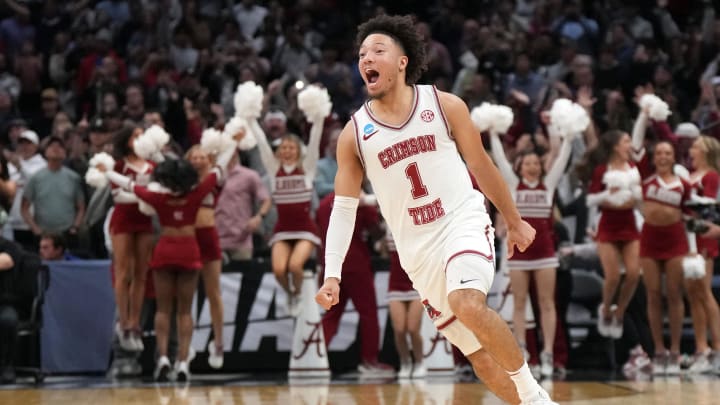Who Would Make the Roster If Team USA Sent Men’s College Basketball Players to the Olympics?

The United States sent a star-studded group of NBA stars to Paris to chase a fifth straight gold medal in men’s 5-on-5 basketball at the 2024 Olympic Games. Led by big performances from Kevin Durant and LeBron James, Team USA got off to a strong start, pulling away from Nikola Jokic and Serbia after an early scare Sunday.
But what if Team USA didn’t have the luxury of sending its biggest stars to chase gold? In men’s soccer, for instance, players have to be under 23 years old (with the exception of three overage players). A U23 rule would likely send several young NBA talents to Paris (including current Team USA player Anthony Edwards, who’s just 22). Restrict it further though, and let’s imagine a world where the Games went back to requiring players to still be amateurs … making college basketball the best avenue to source talent from.
What would a Team USA with only college players look like? Sports Illustrated took a stab at building the roster that would have the best chance at winning gold.
Coach: Dan Hurley, UConn Huskies
The architect of two-time defending national champion UConn has to be the choice to pace the sideline. Installing Hurley’s offense with a new group of players might be a challenge, but his sideline antics in the Olympic setting would be must-watch TV. Plus, the U.S. would have a deep bench of assistants to choose from, including Mark Few, who’s currently an assistant under Steve Kerr for the team in Paris.
Starting Lineup
Guard: Mark Sears, Alabama Crimson Tide
Sears is fresh off a ridiculous statistical season at Alabama during which he averaged over 21 points, four rebounds and four assists while shooting 51% from the field and 44% from three. He’ll be the engine of this U.S. offense, and picking up the pace to play with a 24-second shot clock shouldn’t be a problem after spending the last two years in Nate Oats’s up-tempo system.
Guard: RJ Davis, North Carolina Tar Heels
This would be a diminutive backcourt with both guards standing 6'0" or shorter, but this setting is all about getting your best players on the floor. Davis is among the most electric shotmakers in college basketball and is capable of playing with or without the ball, which should help with roster construction. Having one of Davis and Sears on the floor at all times would help this offense not miss a beat.
Wing: Cooper Flagg, Duke Blue Devils
The top-rated recruit in the 2024 class earns a spot in the starting lineup. Flagg turned heads while with the USA Basketball Select Team during training camp for Team USA, a good sign that his game should translate seamlessly into the FIBA setting. He’s one of the most impactful players per possession in recent high school basketball memory thanks to his ability to pass, defend and protect the rim in addition to his scoring exploits.
Forward: Alex Karaban, UConn Huskies
Karaban brings shooting, toughness and winning DNA to the starting lineup. He has been a part of both national title runs under Hurley at UConn, and adding a gold medal to his trophy case would be the next step for a player gunning to be one of the winningest players in the modern era of college basketball.
Center: Ryan Kalkbrenner, Creighton Bluejays
Team USA’s deepest position is center, with several top-tier options at that spot. From a fit standpoint, let’s pencil in Kalkbrenner, one of the best rim protectors and lob threats in college basketball who has almost single-handedly turned Creighton into a strong defensive outfit throughout his four-year career.
Off the Bench
- Zakai Zeigler, Tennessee Volunteers: One of the best leaders in college basketball plugs in as a defensive pest and shooter off the bench.
- Kam Jones, Marquette Golden Eagles: A hyper-efficient shotmaker, Jones is an elite rim finisher who can make threes off the bounce. Consider him this team’s offensive spark plug.
- Hunter Sallis, Wake Forest Demon Deacons: The former five-star recruit exploded as a junior at Wake Forest. He’s a strong defender with good size and playmaking ability.
- Payton Sandfort, Iowa Hawkeyes: Sandfort’s role is simple: make threes. He made 94 of them last season and is arguably the best returning shooter in the country.
- Ace Bailey, Rutgers Scarlet Knights: An upside swing! Bailey’s ceiling is enormous as a big wing scorer, and his length and athleticism will be nice to have on this roster.
- Johni Broome, Auburn Tigers: Broome was the anchor of the nation’s top-ranked two-point defense a year ago. He’s also a dominant rebounder and a productive post scorer.
- Hunter Dickinson, Kansas Jayhawks: We round out the roster with a 7-footer with over 2,200 career points under his belt. Dickinson’s continued improvement as a shooter gives Team USA a different look offensively as the third center in this rotation.
Tough Cuts
- I considered adding a pair of high school sensations in Cameron Boozer and AJ Dybantsa, each of whom led Team USA to a U17 World Cup gold medal this summer. In the end, I leaned toward the added experience of college-bound players, but both would’ve been hard to turn away.
- There were plenty of options for a backup point guard. Zeigler fit in better because of his shooting and defense, but Iowa State’s Tamin Lipsey and Purdue’s Braden Smith were more than worthy candidates.
- Arizona’s Caleb Love, Arkansas’s Johnell Davis and Florida’s Walter Clayton Jr. all were in the conversation for the spots taken by Jones and Sallis.
